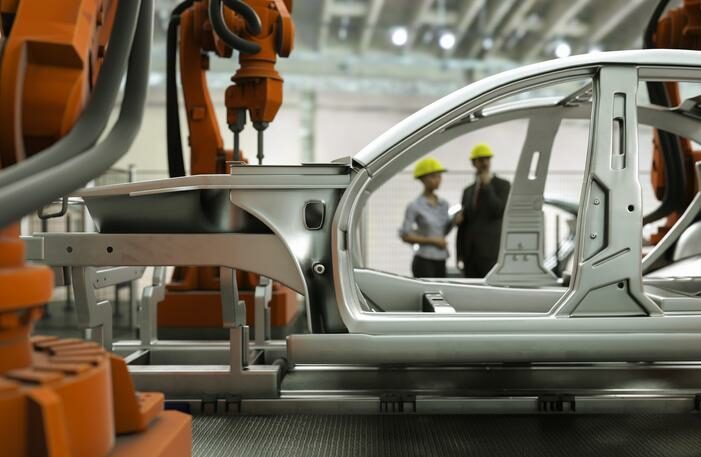

Why relocate production in the industry?
Production relocation checklist - from planning to implementation
Objectives and strategy: Clear definition of the objectives and reasons for relocating production. Definition of long-term strategic goals and expectations.
Site selection: Evaluation of potential locations based on costs, infrastructure, labour, legal framework, etc. Carrying out site analyses and risk assessments.
Budgeting and resource planning: Determination of the budget for the relocation. Resource allocation for the move, including finance, human resources and technology.
Communication and stakeholder management: Clear communication with all stakeholders involved, including employees, suppliers and customers. Develop a communication plan to inform all relevant parties about the progress and impact of the relocation.
Legal and regulatory aspects: Review and compliance with all legal and regulatory requirements at both the old and the new location. Securing the permits and licences for operation at the new location.
Infrastructure and logistics: Ensuring the availability of infrastructure such as factories, warehouses, power supply, water, transport facilities, etc. Planning and implementation of efficient logistics solutions for the transport of raw materials, products and other materials.
Quality assurance and process optimisation: Review and adaptation of production processes and quality standards at the new location. Implementation of quality control measures to ensure that product quality is maintained.
Personnel management: Planning and organising training courses for employees at the new location. Consideration of personnel adjustments and employment contracts.
Technological infrastructure: Evaluation of the existing technological infrastructure and adaptation to the new location. Ensuring the availability of IT systems and other technical support.
Risk management: Identification of potential risks and development of risk minimisation measures. Establishment of a control and monitoring system to monitor the relocation process and recognise problems at an early stage.

1. planning and preparation for a successful relocation of production in the industry
2. selection of the new location for the relocation of production
3. logistics and transport for a production relocation
4. communication with employees during a production relocation in the industry
5 Technological aspects

6. employee training after a successful relocation of production in the industry
7. quality control and process optimisation after a production relocation
Conclusion: Successful relocation - efficient production at new location!
Successful production relocation - with us as your partner

Frequently asked questions:
What is a production relocation?
Why move production abroad?
Reducing costs as labour and resources are cheaper in some countries. Access to new customers and business opportunities. Optimisation of the production process by using specialised expertise and technologies in other countries. Tax benefits and regulatory incentives.
Why do we produce abroad?
Cost savings: Companies can often find cheaper labour, raw materials and production costs abroad. This enables them to offer their products at lower prices and be more competitive. Access to resources: In some countries, there is better access to certain resources such as raw materials, energy or specialised labour. Relocating production to such locations can increase efficiency and improve quality. Market development: By setting up production facilities abroad, companies can improve their access to new markets. This enables them to better serve local customers and expand their market presence. Risk diversification: Diversifying production sites can protect companies from risks such as political instability, natural disasters or currency fluctuations. If one location is affected, production can be continued at other locations. Capacity expansion: If demand for a product increases, relocating production abroad can help to expand production capacity and avoid bottlenecks. Competitive advantage: In some cases, companies abroad can use more advanced technologies, production processes or expertise to gain a competitive advantage.
What can go wrong when relocating production?
Logistics problems: There may be difficulties in transporting equipment, raw materials and finished products. Quality problems: Product quality can suffer if the new production sites do not have the same standards as the old ones. Communication problems: Misunderstandings between the teams at the new and old locations can lead to delays and errors. Cost overruns: The relocation can be more expensive than expected due to unforeseen expenses or inefficient planning. Loss of skilled labour: Experienced employees could leave the workplace or find it difficult to adapt to new processes. Legal problems: Problems with authorisations, certifications or contracts can delay or hinder the relocation process. Technical challenges: Problems can arise with the integration of new technologies or the incompatibility of systems. Loss of productivity: Productivity could drop temporarily while teams adapt to the new work processes. Image and customer relationship problems: Customers could be dissatisfied or lose confidence in the company if problems arise during the relocation. Regulatory risks: Violations of environmental or labour laws at the new location can lead to legal problems.
Who can support the relocation of production?
Management consultant / personnel service provider: Consultancy firms specialising in production relocation can assist companies in planning, implementing and monitoring the relocation process. They offer expertise, advice and customised solutions for the company's specific requirements. Legal experts: Lawyers and legal advisors can assist companies with the legal aspects of relocating production, including contract negotiations, legal requirements at the new location, regulatory compliance and intellectual property protection. Logistics company: Logistics companies can support companies in organising the transport of production facilities, machines, raw materials and finished products. They also offer solutions for warehousing, distribution and shipping.
